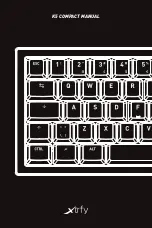
5
Before you compose a Style
For each of the three principal chords (Major, minor, and 7th),
each Style contains four variations each for intro, main, fill-in,
and ending, giving a total of 48 accompaniment patterns.
Each accompaniment pattern is called a “division.”
In the STYLE COMPOSER screen you can check whether or not
a division exists.
1. Select a Style (p. 25 in the owner’s manual).
2. Press [MENU] so the button is lit.
3. Use [
] [
] to select “Style Composer,” and press
[ENTER].
The STYLE COMPOSER screen will appear.
In this screen you can select the division that you want to
edit or record.
You can also access the STYLE COMPOSER screen from the
Main screen by holding down [STYLE].
1.
Chord
2.
Division:
(
■
)
Performance data exists
(•)
No performance data
3.
Variation
Each division consists of eight performance parts: “drums,”
“bass,” and “accompaniment 1–6.”
These eight parts are called Style parts.
You can select a desired part and edit its settings, or newly
record it.
In the STYLE COMPOSER screen, press [ENTER] to access the
STYLE COMPOSER ZOOM screen.
In the STYLE COMPOSER ZOOM screen you can view the
tone used by each part of the selected division.
1.
Tone:
This indicates the Tone assigned to the selected style
part.
2.
Style part:
The name will be highlighted for parts that contain
performance data.
You can assign the following Tones to each style part.
Drums (ADR): rhythm sets
Bass (ABS): tones other than rhythm sets
Accompaniment (AC 1–6): any tone
3.
Move the cursor and press [ENTER] to move to other
screens.
EDIT: STYLE EDIT screen (p. 13)
MICRO: STYLE MICROSCOPE screen (p. 21)
How a Style is constructed
Divisions
1
2
3
Checking the settings for each part of
a Division
Parameter
Value
Explanation
PART
ADR, ABS,
AC1–6
Selects the style part.
ADR: Accomp Drum
ABS: Accomp Bass
AC:
Accompaniment
CHORD
Major,
minor, 7th
Selects the chord.
DIVISION
INTRO1–4,
MAIN1–4,
FILL1–4,
ENDING1–4
Selects the division.
MUTE
OFF, ON
Specifies whether the sound
will be muted (ON) or heard
(OFF).
SOLO
OFF, ON
Specifies whether this part
alone will be heard by itself
(ON) or not (OFF).
1
2
3
Prelude_OM_Ver2.book Page 5 Wednesday, September 9, 2009 5:38 PM






































